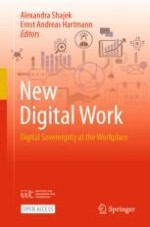Open Access 2023 | Open Access | Buch

New Digital Work
Digital Sovereignty at the Workplace
herausgegeben von: Alexandra Shajek, Ernst Andreas Hartmann
Open Access 2023 | Open Access | Buch

herausgegeben von: Alexandra Shajek, Ernst Andreas Hartmann
This open access book will give insights into global issues of work and work systems design from a wide range of perspectives. Topics like the impact of AI in the workplace as well as design for digital sovereignty at the workplace or foresight processes for digital work are covered. Practical cases, empirical results and theoretical considerations are not only taken from Germany and Europe, but also from Southeast Asia, South Africa, Middle America, and Australia. The book intends to expand the so far national view on the aspects of digital work (e.g. like in Ernst Hartmann’s immensely successful work “Zukunft der Arbeit in Industrie 4.0”) into an international context – thus showing not only common challenges, but also offering suggestions, best practice examples or thoughts from different global regions.